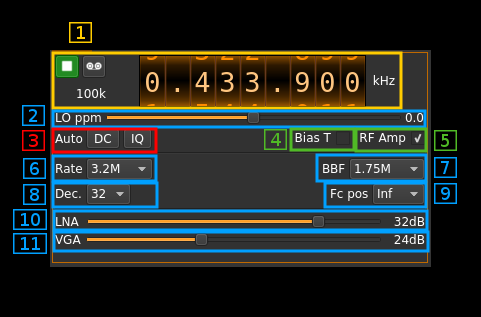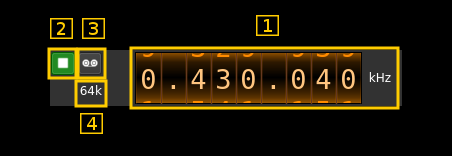HackRF input plugin
Introduction
This intput sample source plugin gets its samples from a HackRF device.
Build
The plugin will be built only if the HackRF host library is installed in your system. If you build it from source and install it in a custom location say: /opt/install/libhackrf you will have to add -DLIBHACKRF_INCLUDE_DIR=/opt/install/libhackrf/include -DLIBHACKRF_LIBRARIES=/opt/install/libhackrf/lib/libhackrf.so to the cmake command line.
The HackRF Host library is also provided by many Linux distributions and is built in the SDRangel binary releases.
Interface
1: Common stream parameters
1.1: Frequency
This is the center frequency of reception in kHz.
1.2: Start/Stop
Device start / stop button.
- Blue triangle icon: device is ready and can be started
- Green square icon: device is running and can be stopped
- Red square icon: an error occured. In the case the device was accidentally disconnected you may click on the icon, plug back in and start again.
Please note that HackRF is a half duplex device so if you have the Tx open in another tab you have to stop it first before starting the Rx for it to work properly. In a similar manner you should stop the Rx before resuming the Tx.
The settings on Tx or Rx tab are reapplied on start so provided the half duplex is handled correctly as stated above these settings can be considered independent.
1.3: Record
Record baseband I/Q stream toggle button
1.4: Baseband sample rate
Baseband I/Q sample rate in kS/s. This is the device sample rate (4) divided by the decimation factor (6).
2: Local Oscillator correction
Use this slider to adjust LO correction in ppm. It can be varied from -10.0 to 10.0 in 0.1 steps and is applied in software.
3: Auto correction options
These buttons control the local DSP auto correction options:
- DC: auto remove DC component
- IQ: auto make I/Q balance
4: Bias tee
Use this checkbox to toggle the +5V power supply on the antenna connector.
5:RF amp
Use this checkbox to toggle the extra low noise amplifier (LNA). This gives an additional gain of 14 dB.
6: Device sample rate
This is the HackRF device ADC sample rate in kS/s. Possible values are: 2400, 3200, 4800, 5600, 6400, 8000, 9600, 12800, 19200 kS/s.
7: Rx filter bandwidth
This is the Rx filter bandwidth in kHz. Possible values are: 1750, 2500, 3500, 5000, 5500, 6000, 7000, 8000, 9000, 10000, 12000, 14000, 15000, 20000, 24000, 28000 kHz.
8: Decimation factor
The device stream from the HackRF is decimated to obtain the baseband stream. Possible values are:
- 1: no decimation
- 2: divide devcie stream sample rate by 2
- 4: divide devcie stream sample rate by 4
- 8: divide devcie stream sample rate by 8
- 16: divide devcie stream sample rate by 16
- 32: divide devcie stream sample rate by 32
10: Internal LNA gain
The LNA gain can be adjusted from 0 dB to 40 dB in 8 dB steps.
11: Rx variable gain amplifier gain
The Rx VGA gain can be adjusted from 0 dB to 62 dB in 2 dB steps.

